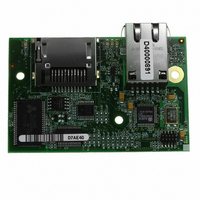20-101-1138 Rabbit Semiconductor, 20-101-1138 Datasheet - Page 36

20-101-1138
Manufacturer Part Number
20-101-1138
Description
RCM4300 RABBITCORE
Manufacturer
Rabbit Semiconductor
Datasheet
1.20-101-1139.pdf
(124 pages)
Specifications of 20-101-1138
Module/board Type
MPU Core Module
Product
Microcontroller Modules
Data Bus Width
8 bit
Core Processor
Rabbit 4000
Clock Speed
58.98 MHz
Interface Type
Ethernet
Flash
2 MBytes
Timers
10 x 8 bit
Operating Supply Voltage
3.3 V
Board Size
72 mm x 47 mm x 21 mm
For Use With/related Products
RCM4300
Lead Free Status / RoHS Status
Lead free / RoHS Compliant
Other names
316-1141
4.2 Serial Communication
The RCM4300 module does not have any serial driver or receiver chips directly on the
board. However, a serial interface may be incorporated on the board the RCM4300 is
mounted on. For example, the Prototyping Board has an RS-232 transceiver chip.
4.2.1 Serial Ports
There are six serial ports designated as Serial Ports A, B, C, D, E, and F. All six serial
ports can operate in an asynchronous mode up to the baud rate of the system clock divided
by 8. An asynchronous port can handle 7 or 8 data bits. A 9th bit address scheme, where
an additional bit is sent to mark the first byte of a message, is also supported.
Serial Port A is normally used as a programming port, but may be used either as an asyn-
chronous or as a clocked serial port once application development has been completed and
the RCM4300 is operating in the Run Mode. Digi recommends that you limit the use of
Serial Port A to a programming port to avoid any possible conflicts with the PIC micro-
controller during boot-up while the program is loaded. If you intend to use Serial Port A as
a regular serial port with the RCM4300 operating in the Run Mode, Serial Port A must be
disconnected from the external device during boot-up in order for the program to load.
Serial Port B, shared by the RCM4300 module’s serial flash, microSD™ card, and A/D
converter, is set up as a clocked serial port. Since this serial port is set up for synchronous
serial communication, you will lose the peripheral functionality if you try to use the serial
port in the asynchronous mode.
Serial Ports C and D may be used synchronously or asynchronously.
The IrDA protocol is supported by all six serial ports.
Serial Ports E and F can also be configured as SDLC/HDLC serial ports. Serial Ports E
and F must be configured before they can be used. The sample program
SWITCHECHO.C
configure Serial Port F.
RabbitCore RCM4300 User’s Manual
NOTE: Since Serial Port B is shared, exercise care if you attempt to use Serial Port B for
other serial communication. Your application will have to manage the sharing negotia-
tions to avoid conflicts when reading or writing to the devices already using Serial Port B.
Any conflict with Serial Port B while the RCM4300 is powering up may prevent an
application from loading from the serial flash when the RCM4300 powers up or resets.
Do not drive or load the Serial Port B or SCLKB (PC4, PC5, and PB0) pins while the
RCM4300 is powering up.
in the Dynamic C
SAMPLES\RCM4300\SERIAL
folder shows how to
IOCONFIG_
36

















